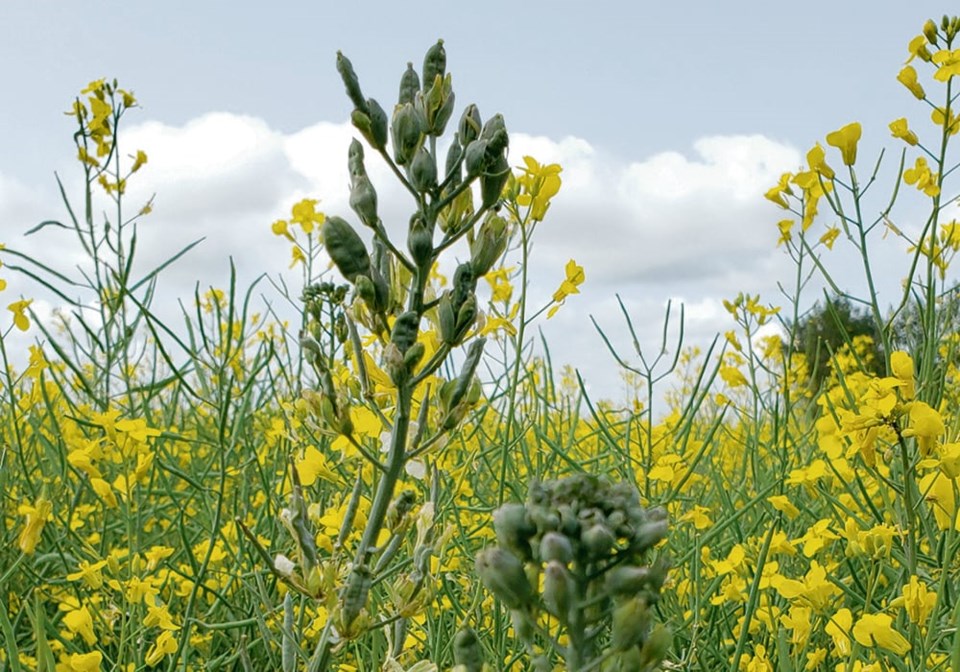WESTERN PRODUCER — Aster yellows could become a significant problem for canola growers this summer.
It’s too early to predict what will happen, but testing done in Saskatchewan indicates that a relatively high percentage of aster leafhoppers are carrying the disease this year.
Aster leafhoppers are responsible for transferring the aster yellows pathogen to canola plants.
The leafhoppers blow into Western Canada from the United States, and a percentage of the insects come with aster yellows.
Canola plants infected with aster yellows turn blue-green in colour, develop misshapen seeds and stand taller than healthy canola plants.
A field with a small number of infected plants is not a problem, but there have been years with severe outbreaks in Western Canada.
“In 2000, 2007 and in 2012 (with a five to 84 percent infection rate), resulting in a significant yield reduction for many growers across the Prairies,” says the Canola Council of Canada website.
The severity of aster yellows in canola in a given year depends on a few factors:
• The number of aster leafhoppers that blow into Western Canada from the U.S.
• What percentage of those leafhoppers are carrying the aster yellows phytoplasma.
• Are the leafhoppers feeding on weeds in Canada that have aster yellows and then spreading the disease to canola plants?
Tyler Wist, a field crop entomologist with Agriculture Canada in Saskatoon, said the conditions this spring look similar to 2012, the last year with a damaging outbreak of aster yellows.
On May 23, Wist and his colleagues used sweep nets at 11 sites in Saskatchewan to see if they could find aster leafhoppers. They found 86.
“Of those 86 … 11 were positive for aster yellows,” he said.
“That’s 13 pe rcent rate of positive.”
More typically in late May, only one percent of aster leafhoppers are carrying aster yellows
“Which suggests they came in (this year) more infected than in previous years,” Wist said.
It’s difficult to know why more leafhoppers have aster yellows this year, but it may be connected to the winter wheat crop in the U.S.
Leafhoppers prefer to reside and reproduce in wheat crops, but the winter wheat in states such as South Dakota and Nebraska struggled this spring because of drought.
When that happens, the leafhoppers abandon the wheat field and move into ditches to feed on weeds and other vegetation that are “reservoirs” of aster yellows, Wist said.
“(So) when they come up to Canada, they’re more infected than they typically are,” he said.
“We had a really bad outbreak here in 2012, and very similar conditions happened in the wheat crop down in the Great Plains … which worries me, that this year could be a really (bad) aster yellows year. Or it won’t. It’s really hard to predict.”
John Gavloski, an extension entomologist with Manitoba Agriculture, said aster leafhoppers have also been found in Manitoba, particularly in the western half of the province.
Samples of the insects are being tested for the aster yellows pathogen.
Dandelions are a source
A percentage of leafhoppers blown into Canada come with aster yellows, but some get infected on the Prairies.
If they arrive in May, before a canola crop has emerged, they will feed on weeds and other foliage near a field.
In a research project conducted from 2018-22, Wist and his team learned that sow thistle, stinkweed and dandelions are hosts for aster yellows.
“If you needed another reason to hate dandelions, they might be another reservoir for the aster yellows phytoplasma,” he said.
“We tested dandelion plants before the aster leafhoppers showed up, and the dandelions were infected (with aster yellows) before we had any aster leafhoppers in the province.”
In his most recent project on aster leafhoppers, Wist is trying to connect the population of aster leafhoppers in the spring with the appearance of aster yellows in canola.
“If we can identify the percentage of leafhoppers carrying the aster yellows pathogen/disease in this migratory population as soon as it arrives in our region … then we can give farmers a heads-up on the potential for aster yellows that year so they can plan accordingly,” Wist said on Agriculture Canada’s website.
He is collaborating with insect experts and producers in other parts of the Prairies, asking people to use sweep nets in ditches and areas near canola fields.
Then, in August, Wist and his team will go into the nearby canola crop to estimate the percentage of plants that have aster yellows. For more information, contact Tyler Wist at [email protected].
Sweeping of ditches and weedy areas needs to happen before the leafhoppers move into canola fields.
Contact [email protected]




